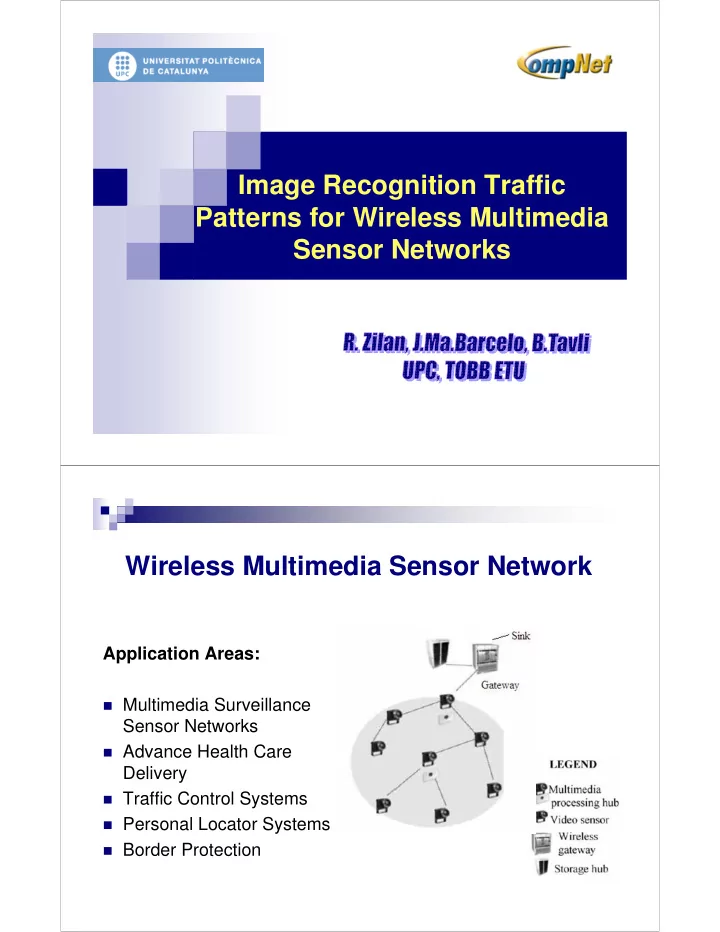

Image Recognition Traffic Patterns for Wireless Multimedia Sensor Networks Wireless Multimedia Sensor Network Application Areas: � Multimedia Surveillance Sensor Networks � Advance Health Care Delivery � Traffic Control Systems � Personal Locator Systems � Border Protection
Challenges in WMSN � Transmission of Visual Data � Requires huge amount of data to be transferred � Low Bandwidth Requirements � Available sensors supports 100Kb/sec-250Kb/sec � Low Power Requirements � Visual data processing computationally could be expensive. Research Areas on WMSN* � Network Architectures � Network Protocols � MAC � Routing � … � Physical Layer � Energy Consumption � Multimedia Encoding Techniques � etc. * IAN F. AKYILDIZ, WIRELESS MULTIMEDIA SENSOR NETWORKS: A SURVEY, IEEE Wireless Communications • December 2007.
Motivation � WSN � Directed Diffusion � 2 events/sec at each event. modeled as 64 byte, 5sec. with a interest duration of 15 sec. � T-MAC � Periodic packets of 50bytes/sec to sink, 30bytes every 4 sec. in the neighborhood of the event and local packages every 20 sec. � WMSN (VBR ???) � The traffic is needed to be characterized. � Problem � VBR traffic in a sensor network may rapidly consume the sensor batteries and also could fill the buffers of the sensors. � Idea : � Instead of whole frames, sending the min. amount of data (recognized object). Aim of the Study � Comparison of whole original frames’ traffic with the recognized objects’ traffic. � Identification some of the traffic characteristics that may be found in Wireless Multimedia Sensor Networks (WMSN).
First Part of the Experimental Setup Experiment � Object Recognition (OR) � identification of an object-of-interest by extraction of features. � Address Event Representation (AER) � an address event sensor that extracts and outputs only a few features of interest from the visual scene.
Object Recognition Techniques and Examples • Motion Detection •Motion segmentation ( Background Subtraction),... • Personal Identification for Visual Surveillance •Iris recognition, face recognition,… • Description Behaviors •Behavior-based object recognition,.. • Object Tracking AER* � Sensitive to light and motion � Only pixels which realize a difference in the light intensity generate the events. � The AER emulator � takes an image from the camera, � after some low-level feature detection (depending on changes of light and intensity) � it produces a frame describing the feature magnitude at each pixel. * T. Teixeira, E. Culurciello, J. Hyuk Park, D. Lymberopoulos, B.Sweeney, A.Savvides, Address Event Imagers for Sensor Networks: Evaluation and Modeling, IPSN’06, April 19–21, 2006, Nashville, Tennessee, USA.
Captured Video Examples Edge Original AER Emulator Detection Encoding I Frames (DCT) P Frames B Frames
I,P,B Frames � I Frames (Intra Frame): � Contains most of the information about the frame � Reduces spatial redundancy, � They are not rely-on other frames. � Based on DCT. � P Frames (Predictive Frame): � Reduces temporal redundancy, � motion estimation and compensation between frames. � Rely-on previous I or P frame. � B Frames (Bi-directional Frame): � Rely-on previous or following I or P frame. Results I: Raw Data and Encoded Data
Results II : Frame Statistics Results III: Separated I and P Frames � Effects on I frames � ~ 50% reduction � After edge detection, Intra frame coding performs better since the background is homogeneous. � Effects on P frames on Edge Detection � A high-size P-frame followed by a short-size P-frame. � Small changes in the motion of the edge of the object
Results IV: AER � AER could produce the same amount of bits as the Edge Detection with a complex coding such as MPEG4. � The advantage of AER imagers is that they reduce the high compression overhead produced by encoders. � However, color or object identification with AER is not possible. Conclusion and Future Work � Traffic should be characterized . � A better understanding of the behavior of such traffic sources could be helpful. � “ Object Recognition Techniques ” are considered as key components for reducing the amount of information to be sent to the sink. � Coding techniques are further considered to reduce the temporal and spatial redundancies in frames. � Although MPEG4 is not a suitable technique for sensor networks , it is used to show the effects of coding on object recognized frames (I&P). � Future work: different object recognition techniques together with coding algorithms to see the amount of consumed power.
Thanks & Questions ???
Recommend
More recommend